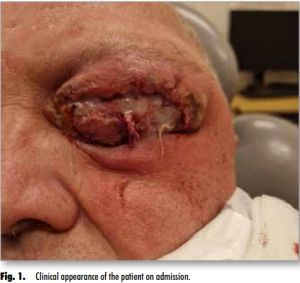OPIS PRZYPADKU
Unilateral Periorbital Necrotizing Fasciitis – A Case Report
1
Department of Cranio-Maxillo-Facial Surgery, Faculty of Medical Sciences in Zabrze, Medical University of Silesia, Poland
2
Department of Ophthalmology, Faculty of Medical Sciences in Katowice, Medical University of Silesia, Poland
Data nadesłania: 06-10-2023
Data akceptacji: 23-11-2023
Data publikacji: 29-12-2023
Ophthalmology 2023;(4):15-18
SŁOWA KLUCZOWE
STRESZCZENIE
Introduction: Periorbital necrotizing fasciitis is rare due to the excellent blood supply to the area, but nevertheless can sometimes lead to death. Knowledge of the symptoms of the disease enables rapid diagnosis, which reduces the possibility of serious complications of the disease and its mortality. To date, few publications describing the disease entity have been presented. Patient description: A 70-year-old male patient was admitted to the hospital with necrotizing fasciitis of the left upper eyelid region, diagnosed on the basis of fulminant development of necrosis and a positive bacteriological test for S. pyogenes. Results: Contrast-enhanced computed tomography showed the presence of a pathological inflammatory infiltrate within the eyelid of the left eye and subcutaneous tissue at the preseptal level of the orbit and left cheek. Blood tests showed leukocytosis (total white blood cell count of 17.33 x 109/ L with 87.1% neutrophils) and elevated C reactive protein parameters (240.64 mg/ L). Empirical intravenous antibiotic therapy was administered: 1 g of amoxicillin with 200 mg of clavulanic acid every 8 hours, 500 mg of metronidazole every 8 hours, and ciprofloxacin into the left and right conjunctival sacs 3 mg/ml every 6 hours. Surgical debridement of upper eyelid necrosis was performed on the second day of hospitalization. Conclusions: The peculiar anatomical structure of the periocular region promotes the dynamic development of necrotizing fasciitis. The close proximity of the central nervous system and the eyeball threatens irreversible consequences, including loss of vision or death. Early appropriate targeted treatment can effectively stop the development of the disease and prevent severe complications.
Udostępnij
Przetwarzamy dane osobowe zbierane podczas odwiedzania serwisu. Realizacja funkcji pozyskiwania informacji o użytkownikach i ich zachowaniu odbywa się poprzez dobrowolnie wprowadzone w formularzach informacje oraz zapisywanie w urządzeniach końcowych plików cookies (tzw. ciasteczka). Dane, w tym pliki cookies, wykorzystywane są w celu realizacji usług, zapewnienia wygodnego korzystania ze strony oraz w celu monitorowania ruchu zgodnie z Polityką prywatności. Dane są także zbierane i przetwarzane przez narzędzie Google Analytics (więcej).
Możesz zmienić ustawienia cookies w swojej przeglądarce. Ograniczenie stosowania plików cookies w konfiguracji przeglądarki może wpłynąć na niektóre funkcjonalności dostępne na stronie.
Możesz zmienić ustawienia cookies w swojej przeglądarce. Ograniczenie stosowania plików cookies w konfiguracji przeglądarki może wpłynąć na niektóre funkcjonalności dostępne na stronie.




